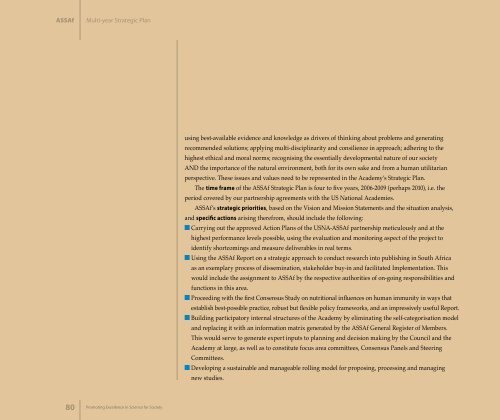Academy of Science South Africa 2005/6 Annual Report
Academy of Science South Africa 2005/6 Annual Report
Academy of Science South Africa 2005/6 Annual Report
- No tags were found...
You also want an ePaper? Increase the reach of your titles
YUMPU automatically turns print PDFs into web optimized ePapers that Google loves.
ASSAfMulti-year Strategic Planusing best-available evidence and knowledge as drivers <strong>of</strong> thinking about problems and generatingrecommended solutions; applying multi-disciplinarity and consilience in approach; adhering to thehighest ethical and moral norms; recognising the essentially developmental nature <strong>of</strong> our societyAND the importance <strong>of</strong> the natural environment, both for its own sake and from a human utilitarianperspective. These issues and values need to be represented in the <strong>Academy</strong>’s Strategic Plan.The time frame <strong>of</strong> the ASSAf Strategic Plan is four to five years, 2006-2009 (perhaps 2010), i.e. theperiod covered by our partnership agreements with the US National Academies.ASSAf’s strategic priorities, based on the Vision and Mission Statements and the situation analysis,and specific actions arising therefrom, should include the following:Carrying out the approved Action Plans <strong>of</strong> the USNA-ASSAf partnership meticulously and at thehighest performance levels possible, using the evaluation and monitoring aspect <strong>of</strong> the project toidentify shortcomings and measure deliverables in real terms.Using the ASSAf <strong>Report</strong> on a strategic approach to conduct research into publishing in <strong>South</strong> <strong>Africa</strong>as an exemplary process <strong>of</strong> dissemination, stakeholder buy-in and facilitated Implementation. Thiswould include the assignment to ASSAf by the respective authorities <strong>of</strong> on-going responsibilities andfunctions in this area.Proceeding with the first Consensus Study on nutritional influences on human immunity in ways thatestablish best-possible practice, robust but flexible policy frameworks, and an impressively useful <strong>Report</strong>.Building participatory internal structures <strong>of</strong> the <strong>Academy</strong> by eliminating the self-categorisation modeland replacing it with an information matrix generated by the ASSAf General Register <strong>of</strong> Members.This would serve to generate expert inputs to planning and decision making by the Council and the<strong>Academy</strong> at large, as well as to constitute focus area committees, Consensus Panels and SteeringCommittees.Developing a sustainable and manageable rolling model for proposing, processing and managingnew studies.80 Promoting Excellence in <strong>Science</strong> for Society









![National Research Foundation Annual Report 2008 / 2009 [Part 2]](https://img.yumpu.com/49774036/1/177x260/national-research-foundation-annual-report-2008-2009-part-2.jpg?quality=85)






